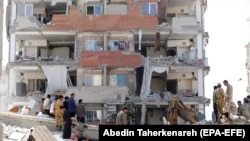Aftershocks continued to rattle Western Iran, two days after a 7.3 magnitude earthquake shook vast areas on the Iran-Iraq border region and beyond.
After midnight, local time, a 4.1 magnitude tremor hit Ghasre Shirin and in the early morning hours, another 3.9 aftershock shook the area.
Tens of thousands of people huddled in emergency shelters or just spent the night in the open, afraid of more aftershocks.
The number of casualties has risen to well over 500 on Tuesday. Another 7,370 people were injured and some of the serious cases have been taken to better hospitals in Tehran. Some are still waiting to be treated in local facilities.
The number of casualties in Iran is much higher than in Iraq. One reason appears to be the widespread destruction of recent government constructed public housing units.
During Mahmoud Ahmadinejad’s presidency, when oil prices were high, tens of thousands of public housing units called Mehr, meaning “affection” were built. These are apartment buildings made of pre-fab concrete panels, much like Soviet era basic residences.
In a devastating earthquake in 1988 in Soviet Armenia, a high level of casualties was thought to be the result of panel apartment building collapsing, while older constructions fared better.
The deputy of Iran’s Housing Administration told the media that 12,000 residential units have been “totally destroyed”.
There are reports on social media that the people of the affected areas are already protesting the shoddy construction that has led to widespread destruction and a high number of casualties.
People also gathered in front of a government building in one the hardest hit towns, Sare-Pol Zahab and vented out their anger about lack of food, water and insufficient recovery efforts.
Local journalist Nishtman Asaadi told Radio Farda that shortages of drinking water and food pose a serious problem for survivors.
There are videos of the aftermath by survivors circulated in social media where citizens show the destruction and complain that many rescuers from the armed forces reached the earthquake zone without any equipment.
Souma Saffari from Sanandaj told Radio farad that 50% of schools have collapsed and the areas main hospital was one of the first building that fell during the earthquake, trapping many patients.
The late summer weather has already changed to an autumn chill and those who cannot not find emergency shelter, spent a second night around campfires. Survivors complained of lack of tents to local media.
"More people will die because of cold. My family lives in a village near Sarpol-e Zahab. I cannot even go there. I don't know whether they are dead or alive," Rojan Meshkat, 38, in the Kurdish city of Sanandaj told Reuters by telephone.
Authorities have announced an end to rescue operations as they said that the chances of finding any survivors were extremely low.




